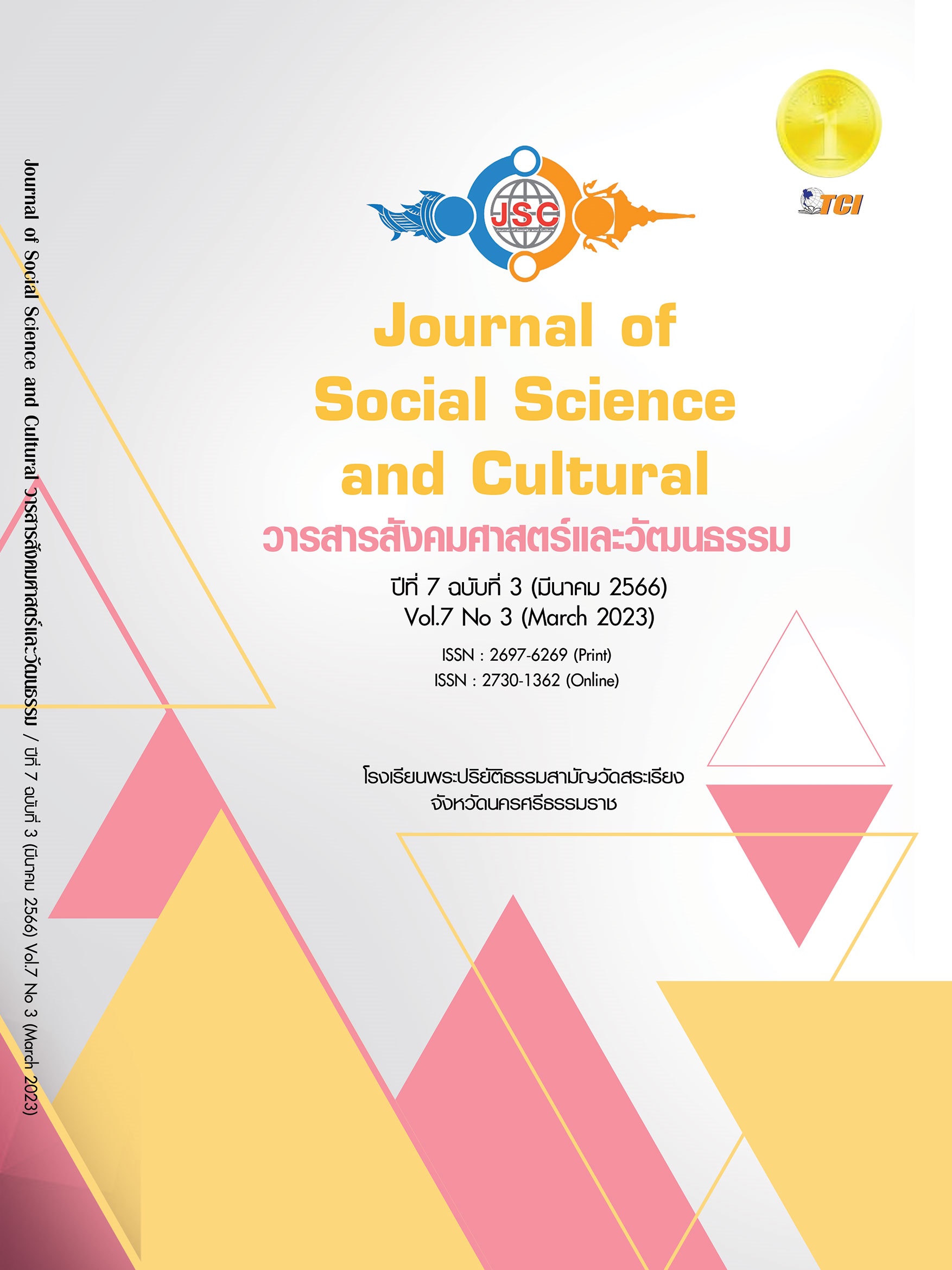PREDICTORS OF POSTPARTUM DEPRESSION AMONG MOTHERS WITH COMPLICATIONS DURING PREGNANCY
Main Article Content
Abstract
The objectives of this article were to identifythe postpartum depression among mothers with complications during pregnancyand factors; maternal age, family income, self-esteem, family functioning, maternal stress and spouse support predicting of thepostpartum depression among mothers with complications during pregnancy. The purpose of this predictive correlational research. A convenience sample was composed of 98mothers during their 4 to 8 weeks postpartum who gave birth with complicationsduring pregnancy and visit postpartum clinic or took their babies to well-baby clinic Sawanpracharak Nakhonsawan Hospital were recruited in this study.. Data was collectedduring June 2021 to December 2021.A system random sampling was used to recruit the sample.Data was collected by using questionnaires comprising the personal data including demographic questionnaires, the postpartum depression assessment, self-esteem assessment, family functioningquestionnaires, maternal stressquestionnaires and spouse supportquestionnaires.Descriptive statistics and Multiple regression analysis were used for data analysis. The results of the study that 14.29percent of mothers with complications during pregnant withpostpartum depression.The percentage of total variance explain by all study variables (self-esteem,family functioning,maternal stress, spouse support)was32.8percent(Adjusted R2 = .351, F4,93 = 17.264, p< .001). The significant variables which predictedpostpartum depression among mothers with complications during pregnant included self-esteem, family functioning, maternal stress(= 0.314, p < .05,
=0.342, p< .001,
=0.316, p < .05respectively)
Article Details
References
กระทรวงสาธารณสุข. (2563). สถิติสาธารณสุข กระทรวงสาธารณสุข. เรียกใช้เมื่อ 12 มิถุนายน 2564 จาก http://healthkpi.moph.go.th/kpi2/kpi/index/?id=1409
กัลพร ยังดี และชุติมา หรุ่มเรืองวงษ์. (2559). ภาวะซึมเศร้าหลังคลอดในมารดาที่มีภาวะแทรกซ้อนทางสูติศาสตร์ ในโรงพยาบาลจุฬาลงกรณ์. วารสารเวชศาสตร์ร่วมสมัย, 6(5), 561-574.
กุสุมา แสนบุญมา และคณะ. (2562). ปัจจัยที่มีอิทธิพลต่อภาวะซึมเศร้าหลังคลอดในมารดาที่ผ่าตัดคลอดแบบฉุกเฉิน. ใน ดุษฎีนิพนธ์คณะพยาบาลศาสตร์ สาขาวิชาการผดุงครรภ์ขั้นสูง. มหาวิทยาลัยบูรพา.
ปิยะภรณ์ ประสิทธิวัฒนเสรี. (2562). การพยาบาลและการผดุงครรภ์ : มารดาที่มีภาวะเสี่ยงและภาวะแทรกซ้อน. เชียงใหม่: บริษัท สมาร์ทโคตติ้ง แอนด์ เซอร์วิส จำกัด.
โรงพยาบาลสวรรค์ประชารักษ์. (2563). สถิติแผนกฝากครรภ์ โรงพยาบาลสวรรค์ประชารักษ์จังหวัดนครสวรรค์. นครสวรรค์: โรงพยาบาลสวรรค์ประชารักษ์.
วรรณี นวลฉวี และคณะ. (2561). ความชุกของภาวะซึมเศร้าหลังคลอดและปัจจัยทำนายภาวะซึมเศร้าหลังคลอดในมารดาหลังคลอด. วารสารมหาวิทยาลัยหัวเฉียวเฉลิมพระเกียรติวิชาการ, 21(42), 65-78.
วันชัย กิตติโชติวัฒน์. (2561). ความชุกและปัจจัยที่เกี่ยวข้องกับภาวะซึมเศร้าหลังคลอดของโรงพยาบาลแก่งคอย จังหวัดสระบุรี. วารสารกรมการแพทย์, 43(5), 125-130.
สุพรรณิกา ปานศรี และคณะ. (2562). ปัจจัยด้านการปรับตัวที่มีอิทธิพลต่อสุขภาพจิตของมารดาหลังคลอด. วารสารพยาบาลทหารบก, 20(2), 160-169.
สุภัสสรา ภูเมฆ และคณะ. (2562). ปัจจัยทำนายภาวะซึมเศร้าของมารดาหลังคลอดที่มารับบริการที่โรงพยาบาลราชวิถี. วารสารวิจัยสุขภาพและการพยาบาล, 35(3), 158-170.
แสงจันทร์ สุนันต๊ะ และคณะ. (2559). ผลของการให้ความรู้และการสนับสนุนมารดาวัยรุ่นครรภ์แรก และยายต่อความสำเร็จในการดำรงบทบาทการเป็นมารดา. วารสารพยาบาลทหารบก, 17(2), 125-134.
อุมาพร ตรังคสมบัติ. (2544). การปฏิบัติหน้าที่ของครอบครัว. จิตบำบัดและการให้คำปรึกษาครอบครัว. กรุงเทพมหานคร: ซันต้าการพิมพ์.
Abate, D. M. et al. (2020). Prevalence of postpartum depression and associated factors among postnatal care attendees in Debre Berhan Ethiopia. BMC pregnancy and childbirth, 20(2), 1-9.
Beck, C. T. (2001). Predictors of postpartum depression: An update. Nursing Research, 50(5), 275-285.
Bessi, M. (2017). Psychological well-being and depression from pregnancy to postpartum among primiparous and multiparous women. Journal of Reproductive and Infant Psychology, 35(2), 183-195.
Chen, J. et al. (2019). A systematic review of prevalence and risk factors of postpartum depression in Chinese immigrant women. Women and birth journal of Australian College of Midwives, 32(6), 487–492.
Cohen, J. (1992). A power primer. Psychological Bulletin, 11(1), 155-159.
Cox, J. et al. (1987). Detection of postnatal depression: Development of the 10-item Edinburgh Postnatal Depression Scale. The British Journal of Psychiatry: the Journal of mental science, 150(6), 782-786.
Faul, F. et al. (2009). Statistical power analyses using G* 3.1: Test for correlation and regression analysis. Behavior Research Methods, 41(4), 1149-1160.
Guodong, D. et al. (2019). Doing the month” and postpartum depression among Chinese women: A Shanghai prospective cohort study. Women and birth journal of Australian College of Midwives, 33(2), 151-158.
Hoang, O. et al. (2016). Factors predicting postpartum depression among women in HaiPhong City Vietnam. Journal of Boromarajonani College of Nursing, Bangkok, 32(1), 92-104.
House, J. S. (1981). Work Stress and Social Support. Massachusettes: Addison Wesley Publishing Company.
Lazarus, R. S. (1984). Coping and adaptation in handbook of behavioral medicine. New York: Guilfort press.
Lowdermilk, D. L. (2016). Maternity & Women,s Health Care (11th edition). New York: Elsevier.
Muraca, G. M. & Joseph. K. S. (2014). The association between maternal age and depression. Journal of obstetrics and gynaecology Canada, 39(9), 803-810.
Peiqin, L. et al. (2020). Prevalence and factors associated with postpartum depression during the COVID-19 pandemic among women in Guangzhou China: a cross-sectional study. BMC Psychiatry, 20(1), 1-8.
Perry, S. E. et al. (2014). Maternal Child Nursing Care (5thed.). Canada: Elsevier.
Romero, A. M. O. et al. (2012). Coping and adaptation process during puerperium. Columbia Medica, 43(2), 167-174.
Rosenberg, M. (1989). Society and the adolescent self-image.Middletown, Connecticut: Wesleyan University Press.
Sitotaw, K. et al. (2018). Prevalence and associated factors of postpartum depression in Southwest Ethiopia: a cross-sectional study. BMC Research Notes, 11(1), 1-7.
Vaezi, A. et al. (2018). The association between social support and postpartum depression in women: a cross sectional study. Women and birth journal of Australian College of Midwives, 32(2), 238-242.


